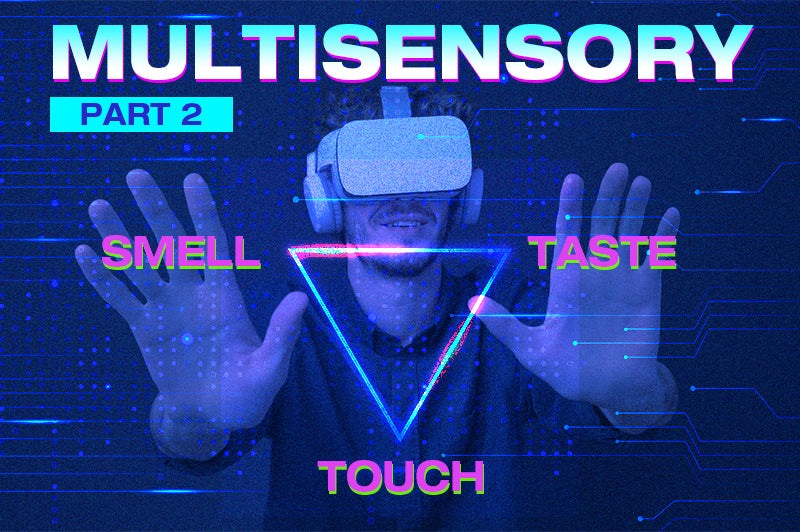This is the second part in a two-part series where we go over some of the cutting-edge technology designed to provide a realistic Virtual Reality (VR) experience through stimulating the senses. In part one, we took a very brief look at the history of multisensory VR and explored some current sensory technology for stimulating our sense of smell and taste. If you haven’t read part one yet, you can find it here.
In this second part, we’ll start by taking a look at current technology designed to simulate our sense of touch, otherwise known as haptics.
Touch
The sense of touch can be stimulated by electronic technology called haptic devices that deliver a physical tactile experience. bHaptics is one of the leading commercial companies supplying haptic devices to consumers at affordable prices. Currently, their range includes a haptic vest, face cover, sleeves, shoes and gloves that vary in price from $149 to $599 USD.
These devices are able to produce tactile stimulation through vibrations at various ‘feedback points’ located in the wearables. The feedback that the bHaptics range delivers helps to make interactions feel more natural and realistic. For example, if someone were to touch your avatar’s body in the metaverse, you could feel that touch through vibrations in the corresponding feedback points on your bHaptics vest.
Whilst these wearables provide some form of tactile feedback, they are limited in that they cannot produce force feedback. This means if you were to grasp a virtual ball whilst wearing bHaptics gloves, it would be felt through vibrations in the fingers, but wouldn’t simulate the feeling of holding a real physical object.
More advanced haptic technology like the TESLAGLOVE go beyond simple vibrations. This wearable has an exoskeleton design that is able to provide force feedback by gently pulling the fingers back when grasping an object. This can simulate the feeling of holding a solid object and is even capable of replicating the feel of various surface types.
However, the price difference between the bHaptics glove ($299) and the TESLAGLOVE (around $15,000) is pretty staggering and makes this kind of force feedback technology too pricey for the average consumer right now.
The same company who makes the TESLAGLOVE also sells the TESLASUIT. This is a full-body wearable that looks a bit like a wetsuit and provides haptic feedback through electro muscle stimulation (EMS) and transcutaneous electrical nerve stimulation (TENS). This means it uses electrical stimulation to create sensations on the skin or cause targeted muscle contractions. For example, the TESLASUIT could mimic the experience of recoil when firing a weapon in VR by making certain muscle groups in the arm contract.
Again, much like the TESLAGLOVE, the TESLASUIT offers a whole new level of haptic experience beyond the bHaptics range, but this comes at a cost of around $8500 USD or more. In addition to cost, another drawback of the TESLASUIT design is that it needs to be in contact with the skin to work.
This means the TESLASUIT requires regular washing to prevent it from getting too dirty, especially if you tend to work up a sweat in VR. The next device however, might solve that problem by creating physical sensations without needing to be in contact with the skin by using ultrasonic sound waves.
Researchers at the Future Interfaces Group have found a way of using ultrasonic transducers to send acoustic waves to a users mouth to create a physical sensation. This ultrasonic wave is a soundwave that we cannot hear but we are able to pick up a feeling of pressure using our sense of touch.
According to the researchers, this device can produce a range of sensations on the mouth, tongue and lips, ranging from tapping, to swipes and vibrations. And because it transmits these sensations through waves, there’s no need for the device to touch the mouth. There is also no reason why this type of technology couldn’t also be applied to other areas of the body.
Whilst this tech is certainly exciting and it’s good to see researchers striving for ever more immersive VR experiences, getting ‘touched’ in VR means it is also likely to bring up a minefield of potential ethical issues too.
The future of sensory VR technology
The technology required to stimulate all five of our senses in VR already exists here but clearly there is still a long way to go. Some sensory technologies are still in the research phase whilst others are further along in their development, like haptic devices, which are currently available to purchase.
In the not too distant future, we can expect that these technologies will become more available and affordable for consumers. There will also be improvements that make them better at stimulating the senses and more ergonomic. Don’t be surprised if you get to try out and purchase much of the technology listed here within the coming decade.
Looking much further ahead, it is possible that we eventually avoid the sensory organs altogether by using technology that interfaces directly with the brain. Something like Neuralink could provide neural implants that enable direct brain stimulation so we can touch, taste and feel anything without the need for any of these external devices. Although, we could be waiting a while for brain interfacing technology like this to become commercially available.
As a company dedicated to providing innovative and original content, we pride ourselves in also working with influencers that amplify this dedication. Therefore we are honored to collaborate with Tony from VR Reviews helping us to share the latest virtual reality news on our website, please click the image below to find out more.


